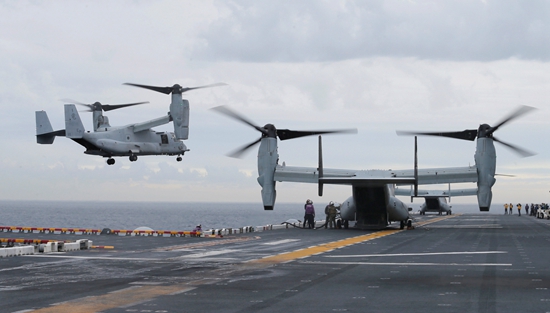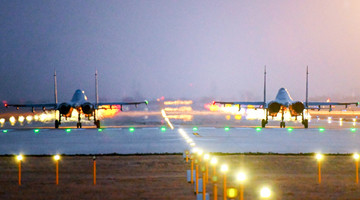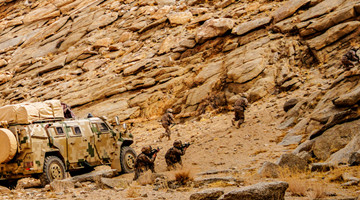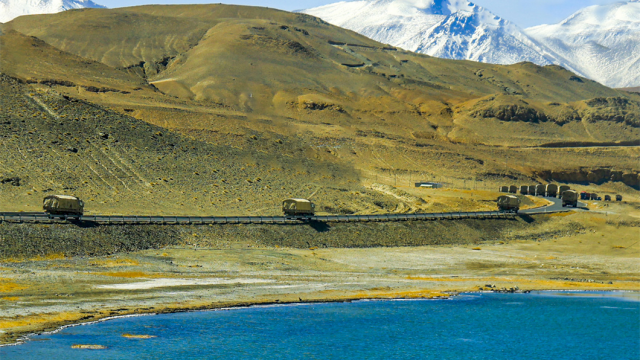
The Trump administration has launched three important strategic documents in the past two months -- the National Security Strategy, the National Defense Strategy and the Nuclear Posture Review. The three reports set forth the US strategies and policies from the perspective of overall national security, national defense and nuclear issues. They will provide guidance and support to the US Indo-Pacific Strategy which is being implemented.
US President Trump's trip to East Asia in early November 2017 proclaimed that the Indo-Pacific Strategy has become the new Asia-Pacific strategy of the US. The goal of the strategy is to stop the rise of China, weaken China's influence, so as to maintain, ensure and consolidate the supremacy of the US in the Indian Ocean-Pacific region through comprehensive measures of a political (democratic values), diplomatic (allies) and military (military exercises, arms sales, etc.) nature.
Among the four core nations of the Indo-Pacific Strategy, the US is the leader and Japan and Australia play the roles of "North Anchor" and "South Anchor" in the Asia-Pacific alliance system of the US. The US and Japan are trying very hard to ally with India. This strategy fits the anxiety and discomfort of some regional countries toward China's development and has triggered a series of reactions.
US: Allies and interests at the same time
Japanese Prime Minister Shinzo Abe proposed the establishment of a "group of four" targeting China consisting of the US, Japan, India and Australia in 2007. However, it was shelved for some reason. The regional defense forum Raisina Dialogue was held in New Delhi on Jan. 18, 2018. Although this is an academic forum, it is also the dialogue of the US, Japan, India and Australia to some extent.
At the same time, military cooperation between the US and other countries in the region is also being promoted in an all-round way.
Indonesia is geographically located at the junction of the Indian Ocean and the Pacific Ocean and is highly valued by the US because it covers several straits that cross the two oceans.
On Jan. 23, US Defense Secretary Matisse visited Indonesia, saying the US hopes Indonesia will play a pivotal role in the security of the South China Sea and the Pacific Ocean. In response, Indonesia's defense minister responded by saying that "the situation in the South China Sea has cooled down and we are committed to maintaining this favorable momentum so as to safeguard the common interests of the region."
The territorial distribution of Vietnam is a natural advantage for monitoring the South China Sea and therefore Vietnam is an important starting point for the Indo-Pacific Strategy of the US. For this reason, the US has stepped up efforts to improve its relations with Vietnam.
In May 2017, the US decided to donate the retired Hamilton class ocean-going law enforcement ship Morgenthau to Vietnam. Matisse visited Hanoi on Jan. 25 and the two sides agreed that a US aircraft carrier will visit Vietnam in March 2018. This will be the first US aircraft carrier visit since 1975, during the Vietnam War.
Singapore is a key link in the Indo-Pacific Strategy. The Changi Naval Base is the only foothold of the US military in Southeast Asia. Singaporean Prime Minister Lee Hsien Loong made a visit to the US on Oct. 21, 2017. Trump said when meeting with Lee that they have maintained a good relationship in the past few decades, but it has never been as close as it is now.
The basic mode of action of the US is to realize its interests by forming an alliance. The pattern has been proved in the Gulf War and the Kosovo War. However, Trump exposed that pattern more directly.
In his first visit to Japan, Trump not only criticized Japan for making a favorable bargain in bilateral trade, but also demanded that Japan should bear more security responsibilities. During his second visit to South Korea, Trump also demanded that South Korea should bear more security spending and even threatened to renegotiate the free trade agreement between the two countries.
Tina Kaidanow, Principal Deputy Assistant Secretary for Political-Military Affairs of the US Department of State, arrived in Singapore to attend the Singapore Airshow on Feb. 5. After making some attacks on China, Kaidanow said that the US has even more advantages in arms and that the US will do its utmost to provide American weapons such as the F-35 fighter jet to Southeast Asian countries. This kind of sales strategy is not decent at all.
Japan: More foreign allies to make up for its limited capability
Japanese Prime Minister Shinzo Abe was the first and foremost promoter of the Indo-Pacific Strategy. Deep-rooted feelings of insecurity and anxiety among Abe and the Japanese people come from the depths of their national character, history and culture. Because of DPRK's nuclear test and other reasons, Abe and the Japan public believe that Japan is facing an urgent and huge "national crisis."
The US is the cornerstone of the umbrella protecting Japan's national security and Japan must actively follow up and even lead the implementation of the Indo-Pacific Strategy in order to win over the US and Trump. This is regarded as Japan's "great cause of national salvation" to ensure national security.
Japan has actively promoted the deployment of advanced weapons including the F-35 stealth fighter. At present, F-35s are deployed at the Kadena Base in Okinawa Prefecture, Iwakuni Base in Yamaguchi Prefecture and Misawa Base in Aomori Prefecture.
There will be more than 80 F-35As deployed in Misawa alone. Japanese defense minister Itsunori Onodera said that the deployment of the F-35 is of great significance to Japan's security.
At the same time, Japan is actively seeking to update its existing missile defense system. The Japanese government decided to deploy the ground-based Aegis anti-missile system and also urged the deployment of the "Terminal High Altitude Area Defense" (THAAD) system on Dec. 9, 2017.
In addition, the joint military exercises between the US and Japan are also constantly being strengthened. The US sent about 14,000 officers and men as well as the Reagan aircraft carrier and several Aegis destroyers to the US-Japan naval Annual Exercise 2017 held from Nov. 16 to 26, 2017 in the waters around Okinawa. The Japanese Ground Self-Defense Force and the US Marine Corps held a joint exercise with a focus of "recapture of outlying islands" in California on Feb. 5, 2018.
While strengthening its integration with the US, Japan is seeking military cooperation with Australia, India, Vietnam and many other countries. Australia, located at the hub of trans-Oceania, will significantly enhance Japan's military capabilities in the South Pacific and the Eastern Indian Ocean.
Australian Prime Minister Turnbull said on Jan. 18, 2018 during a visit to Japan that there will be more joint exercises, information sharing and cooperation in defense industries between Australia and Japan.
The defense relations between Japan and India are also being constantly strengthened. Japanese Prime Minister Abe visited India and met with Indian Prime Minister Modi on Sept 13, 2017. Abe and Modi held a dialogue on cooperation in various fields such as high-speed rail, trade and defense. India plans to buy Japan's US-2 amphibious aircraft, and an India-Japan nuclear cooperation project will also begin.
India: Jealous of other’s developments
Over the years, China has become India's hypothetical enemy in the development of missiles and nuclear weapons and the introduction of advanced weaponry. China has adopted the "going global" strategy led by the Belt and Road Initiative. The construction of the Gwadar Port and the China-Pakistan Economic Corridor in Pakistan does not target any country, but India still feels threatened.
In order to aggravate India's "China paranoia," some US media have ulterior motives in depicting the so-called string of pearls used by China as meant to block India, and India took the bait without any thought. The then Indian Naval chief of staff Sureesh Mehta said that "Each pearl on this string is part of the chain of existence of the Chinese Navy. China may control the energy throat of the world."
US Defense Secretary Matisse visited India on Sept. 26, 2017. In addition to enhancing bilateral defense relations, Matisse’s other major task is to sell weapons. India plans to buy 70 F-16 Block 70 and F / A-18 Hornet aircraft at a cost of up to $15 billion to replace its MiG-series fighter jets. India has purchased $15 billion worth of weapons from the US over the past 10 years.
Singapore's friendly relations with India are beyond imagination. In 1964 when China's first nuclear bomb was successfully completed, Lee Kuan Yew immediately called for India to carry out nuclear tests to "balance" China. After the death of Lee Kuan Yew in 2015, the Indian government announced immediately that Prime Minister Modi would attend the national funeral of Lee Kuan Yew, and also declared March 29, the day of the national funeral in Singapore, a day of mourning in India.
After Modi took office, he implemented India's "eastward" policy as the eastward strategy. Singapore is the best partner for India's eastward strategy. The two countries signed a bilateral agreement between air forces in 2007. In 2008, they signed a bilateral agreement between their armies. The navies of the two countries have conducted joint exercises on a regular basis since 1994.
Singapore's Minister of Defense Ng Eng Hen visited India and signed an agreement on naval cooperation between the two countries, including maritime security cooperation, joint exercises, temporary use of each other’s naval facilities and provision of logistics support with the Indian Defense Minister Nirmala Sitharaman on Nov. 29, 2017. Ng Eng Hen said that Singapore welcomes the frequent visits of the Indian Navy, and that the Changi military base is open to India at any time.
India's gesture of geostrategic and military competition with China is entirely a misunderstanding or misinterpretation of China's strategic intention. Mao Zedong once said: "India was not, is not and will not be an enemy of China’s." This judgment and statement of position still applies today.
Both China and India are populous developing countries and therefore economic development and the improvement of people's livelihoods are the major tasks for both countries. Therefore, regional peace is the most crucial common interest between both sides and China and India should start pragmatic cooperation instead of an arms race.
Australia: Bet on both sides
Australia aims to become a "medium-sized power" and hopes to occupy a place in international politics. However, due to the sparse population, weak economic and military strength and limited overall national strength, the role played by Australia in geopolitics in the world is not prominent. In order to enhance its voice and influence in the international arena, Australia's main theme of foreign relations is to develop a special relationship with the US. This is meant to ensure that it will not be absent from the Indo-Pacific Strategy.
Australia's national security has long relied on the Asia-Pacific hegemony system of the US. Australia is a Western country based on the values of democratic freedom. National security interests and values have brought Australia closer to the US and Japan in military affairs and diplomacy. Its economy is also very dependent on the US.
According to the data from the Australian Department of Foreign Affairs and Trade in 2016, the US investment in Australia reached 10 trillion Australian dollars, about 10 times the size of China's investment in Australia. However, China has been Australia's largest trading partner since 2010. In 2016, the trade volume between China and Australia reached $107.8 billion and Australia’s trade surplus surpassed $33.5 billion. Chinese tourists spending in Australia reached 46 billion yuan in 2016.
The huge economic interests and values and sense of security have left Australia with a dilemma. On Nov. 23, 2017, the Australian government released the first white paper on foreign policy since 2003, saying that Australia is committed to developing a strong and constructive relationship with China while exaggerating the challenges posed by the rise of China and urging the US to maintain its presence in the Western Pacific. Professor Hugh White of the Australian National University believes that the idea "rely on China to make us prosperous and rely on the US to make us secure" is naive and unsustainable.
The theoretical basis and behavioral models of the Indo-Pacific Strategy is a reflection of the Cold War mentality based on ideology and the demarcation of friend or enemy. This definitely goes against the economic globalization, cultural inclusion, political pluralism, shared interests and other requirements of our times.
In a society where the exchange of personnel is becoming increasingly active, economic activity is permeating and integrating, and cultural psychology is increasingly open, it is rather difficult to classify friends or foes. Perhaps it is the reason why the US treats China as a very "high" concern among the three major strategic documents but emphasizes cooperation with each other at the practical level.
As the Indo-Pacific Strategy is in full swing, we cannot neglect it, but we also do not need to be inexplicably nervous. As long as the intricate international situation, and the intertwined interests remain the same and the rules of the game remains the same, the rule of "working together, we could achieve major undertakings that serve our own interests and those of the world. In confrontation, it will surely spell disaster for both countries and the wider world" will still apply between China and the US, China and Japan, China and India and China and Australia.
Therefore, in any one of the bilateral relations, we should broaden our common interests and find ways to solve differences. The US, Japan, India and Australia really need to consider the future of the Indo-Pacific Strategy seriously.
(Wu Minwen at the College of Information and Communication of the PLA National University of Defense Technology)









